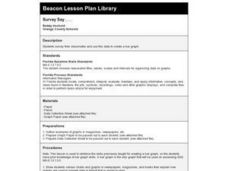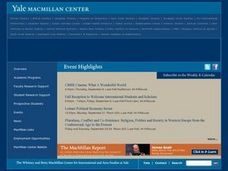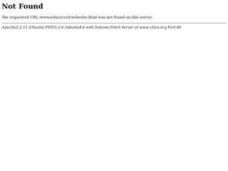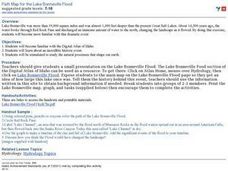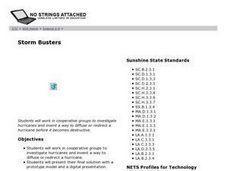Curated OER
Decomposition
Students create a compost pile and chart changes as the materials decompose. Students draw pictures of items placed into their "landfill" and predict how and whether the item will change or not. After two weeks, students write...
Curated OER
Decomposition
Students create a compost pile and chart changes as the materials decompose. Students draw pictures of items placed into their "landfill" and predict how and whether the item will change or not. After two weeks, students write...
Curated OER
Awesome Animals
Young scholars collect data from classmates about their favorite animal. They use the ClarisWorks graphing program to enter data, graph results, and interpret data.
Curated OER
Understanding the Steps in a Process
Students read, "Center for Drug Evaluation and Research: FAQs", and discuss with questions embedded in the lesson.
Curated OER
Survey Say...
Students examine a variety of charts and graphs that present data in a format that is easy to read. They work in groups to conduct a survey amongst their classmates. The data collected from the survey is then put on a bar graph.
Curated OER
Chart/Graph
Students create a class survey, place the data in a spreadsheet and graph the information.
Curated OER
Water Quality and Temperature
Students evaluate the effects of temperature changes on the metabolic rate of a clam. Conclusion questions are addressed which help students to process and articulate their experiences.
Curated OER
Something Fishy
Students identify and discuss the adaptive characteristics and behaviors of fish. They view slides of fish, and design and create a model of a fish of the future, listing the ways their fish adapt to survive.
Curated OER
Hajigul's Story: A Creative Drama
Students listen to stories about and research the life of an Uighur child from China. They investigate their own cultural heritage and design a mural.
Curated OER
Crazy Critters
Eighth graders visit a local park to collect insects. They record the habitats, identify the insect and write a report including the kingdom, phylum, class, and order.
Curated OER
Compost Columns
In this unit of lessons, students examine the role of compost columns and recycling. They create a KWL chart about garbage in Chicago. They also examine life cycles and packaging of everyday products.
Curated OER
Don't Trust Your Eyes
Students brainstorm a list of possible actions that they could do to protect the water resources from pollution. They create hypotheses and conclusions by completing experiments and observing different pollutants.
Curated OER
Snacks in a Bag
Learners brainstorm a list of their favorite snacks. Using clues, they identify the type of snack being described. On a map, they identify and locate the origin of the ingredients used to make it. They write their own clues for...
Curated OER
Water Pollution Lesson Plan: Don't Trust Your Eyes
Learners develop a list of actions they could perform that would protect our water resources from pollution. They formulate hypotheses, conduct experiments and draw conclusions about actual pollutants found in our water supply.
Curated OER
Ground Beef Lab - Open-Faced Tacos
Students will use ingredients and read a recipe to create open faced tacos. The emphasis of the lesson plan is the kind of preparation that is needed to cook ground beef correctly to avoid diseases associated with improper preparation...
Curated OER
Insect Safari
Third graders name and identify three body parts of an insect, identify the characteristics that insects have six legs and one pair of antennae and categorize insects as to whether they are helpful or harmful.
Curated OER
Smog Be Gone
Students begin the lesson by identifying greenhouse gases. In groups, they observe and record the effect of the gases on the atmosphere and the temperature of the Earth. They participate in activities that describe the role of...
Curated OER
Geography: Lesson One
Students pretend they have been chosen to receive an elephant for a pet. Individually, they use the internet to research where elephants come from, their diet and sleeping behaviors. They identify their habitat and their characteristics...
Curated OER
A Seed Grows
Second graders begin the instructional activity by planting their own bean seed. Individually, they make predictions about how many leaves and roots their plant might grow and each day record their observations. They graph the results of...
Curated OER
Path Map for the Lake Bonneville Flood
Pupils use a digital atlas of Idaho to explore the effects of the Lake Bonneville Flood. They become familiar with how floods shape our earth and change landscapes. Students graph a a timeline of the rise and fall of Lake Bonneville.
Curated OER
The Human Cheek Cell
Students list the parts of cell theory and describe and define vocabulary. In this cell lesson students complete a handout that includes sketching a cell.
Curated OER
Preventing Picky Eaters
Students list the normal eating habits of children. In this health lesson, students identify common problems experienced during mealtimes. They discuss ways to better manage a child's mealtime experience.
Curated OER
Storm Busters
Middle schoolers investigate hurricanes and invent a way to diffuse or redirect a hurricane before it becomes destructive in this technology-based science project. Cooperative learning groups are emphasized.
Other popular searches
- Reading Food Labels
- Reading Nutrition Labels
- Nutrition Food Labels
- Interpreting Food Labels
- Read Food Labels
- Food Labels for Nutrition
- Examples of Nutrition Labels
- Meat Food Labels
- Fill Out Food Labels
- Fast Food Nutrition Labels
- Nutrition Facts Pie Graph
- Calculating Food Labels




